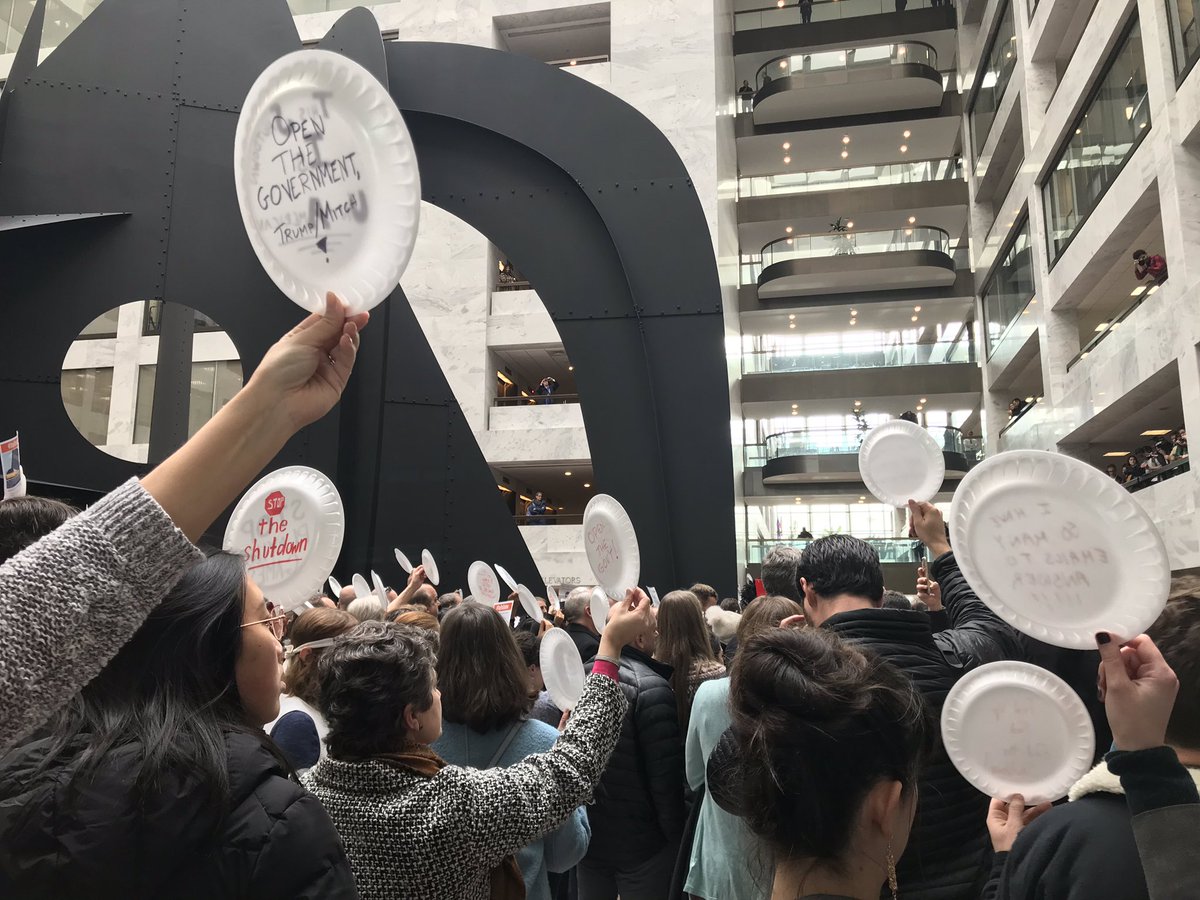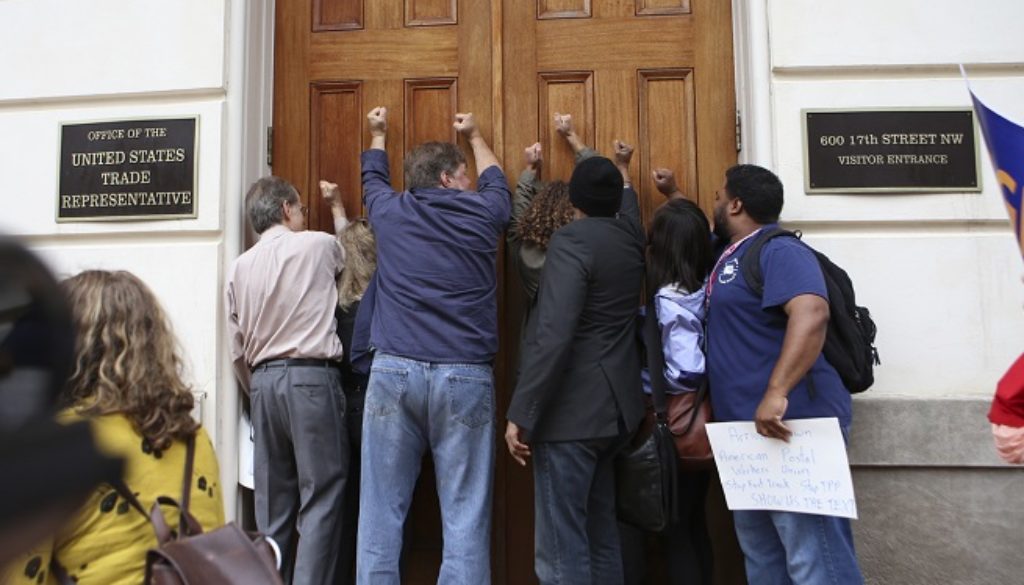When Federal Workers Were Locked Out, Where Were Those Right to Work Groups?
By Leo W. Gerard, United Steelworkers
Thousands of federal employees protested at the Hart Senate Office Building in Washington, D.C., this week, holding aloft empty plates during 33 minutes of silence – one minute for each day of the government shutdown. Some plates carried the message, “Will work for pay.”
Unions representing the 800,000 federal workers who were either locked out or forced to work without pay organized the demonstration. It was supported by the federation of labor unions, the AFL-CIO, and many other unions including the Teamsters, Unite Here and Service Employees International Union (SEIU).
Since the day in December that President Trump shut down the government, the unions representing government workers, including the American Federation of Government Employees, the National Federation of Federal Employees and the Professional Aviation Safety Specialists, supported their members by organizing public protests across the country, establishing food banks, and filing lawsuits to reopen government.
These are the organizations – unions – that reactionary far-right groups have spent the last seven months urging workers to quit. “Get out now that you can,” the right wingers calling themselves right-to-work patrons told public sector employees in YouTube videos, Facebook ads, Tweets, telephone calls and door-to-door solicitations. They spent millions trying to kill the unions that buttressed laid off federal workers. So where were those right-to-work groups during the shutdown? Where was the National Right to Work (RTW) Foundation when hundreds of thousands of federal workers were locked out of their jobs and really wanted the right to work – with pay?
Nobody’s heard a peep from them.
That’s because they’re all bogus. They’re not about a right to work. They’re about destroying unions, and the higher wages and better benefits that collective bargaining gets for workers. They’re not going to help federal workers get back on the job. They’re interested only in ensuring that the millionaires and billionaires that bankroll RTW keep more money in their pockets while workers get less.
Here is the bottom line, right from the U.S. Department of Labor earlier this month. The typical union member earns $191 more a week than a non-union worker. That’s money the union worker can spend on decent housing, a reliable car, a new golf club or trip to the spa. That spending gins up the economy, creating jobs for other workers. It pulls more workers into the middle class.
By contrast, for non-union workers, it’s $191 for every one of them every week that is put in the pockets of fat-cat CEOs and already-wealthy stockholders. The one percenters use some of that extra cash to finance RTW groups, including those that call themselves sanctimonious and deceptive names like “The Fairness Center” and the “Freedom Foundation” while they plot to destroy the collective bargaining that gets $191 more for union workers.
Last June, the deceptive groups thought they’d scored a death blow to public sector unions. Ultra-conservative one percenters had bankrolled a lawsuit all the way up to the now ultra-conservative U.S. Supreme Court. It was called Janus v. AFSCME. And those one percenters got what they paid for.
The court majority overturned a 40-year-old precedent and said that from now on, public sector workers who chose not to join the union could no longer be charged a small fee to cover the cost of collective bargaining and other union services. Federal law still requires unions to provide these services to non-members at organized workplaces. The deceptive groups believed Janus would starve public sector unions to death as they hired staff for collective bargaining and lawyers to represent workers in grievances while workers stopped paying for those services.
But public sector unions didn’t die. The same Department of Labor news release that said union workers earn $191 more a week also said public sector union membership dipped only 0.5 percent last year. Hardly a death knell, it’s fairly consistent with annual declines over the past decade. Also, the private sector rate declined slightly, and private sector unions are unaffected by the Janus decision.
Those public sector unions clearly are offering their members something valuable, something that makes workers willing to join and pay dues despite deceptive groups’ arm twisting to quit. The food banks are great, but the lawsuits that unions representing federal workers have filed are probably the best example of public sector unions’ value right now.
It’s hard enough for an individual or even a group of individuals to get the money together to hire a high-profile, experienced law firm to take on the federal government. It would be impossible for workers who now haven’t been paid in a month, who can’t make their car loans, utility bills and mortgages. But for their unions – which are all the workers joined together – it is possible.
The National Treasury Employees Union and the National Air Traffic Controllers Association filed a suit together that was the first to get a hearing. They lost the first round because the judge said he would not be responsible for the chaos that would ensue if he issued an order forbidding federal employees to work without pay. There’s another hearing in that case, however, scheduled for Jan. 31, during which the judge will consider the unions’ request for a preliminary injunction against the government.
Workers can win. A suit filed after the 2013 shutdown succeeded. It argued that failing to pay federal workers on their regularly scheduled payday violated the Fair Labor Standards Act. The judge ordered the government to pay double the amount owed to 25,000 workers.
This time, the American Federation of Government Employees hired the lawyer who represented the workers in that case, Heidi Burakiewicz. She filed suit for them in December alleging that Trump illegally forced more than 400,000 federal employees to work without pay. The actual number, estimated at 420,000 initially, rose as Trump last week ordered more workers back on the job without pay, including 36,000 Internal Revenue Service employees, 2,200 Federal Aviation Administration safety inspectors and 400 Food and Drug Administration safety workers. (That reduced the number locked out to about 340,000.)
Using Burakiewicz’ successful Fair Labor Standards Act tactic, the National Treasury Employees union also filed a lawsuit asking a judge to order the government to pay workers.
So where were those RTW groups? They were as ghosted from the crisis as Senate Majority Leader Mitch McConnell. They don’t really give a damn about public sector employees’ right to work. They’re all about lining the pockets of those with already-bulging pockets.

